步骤34
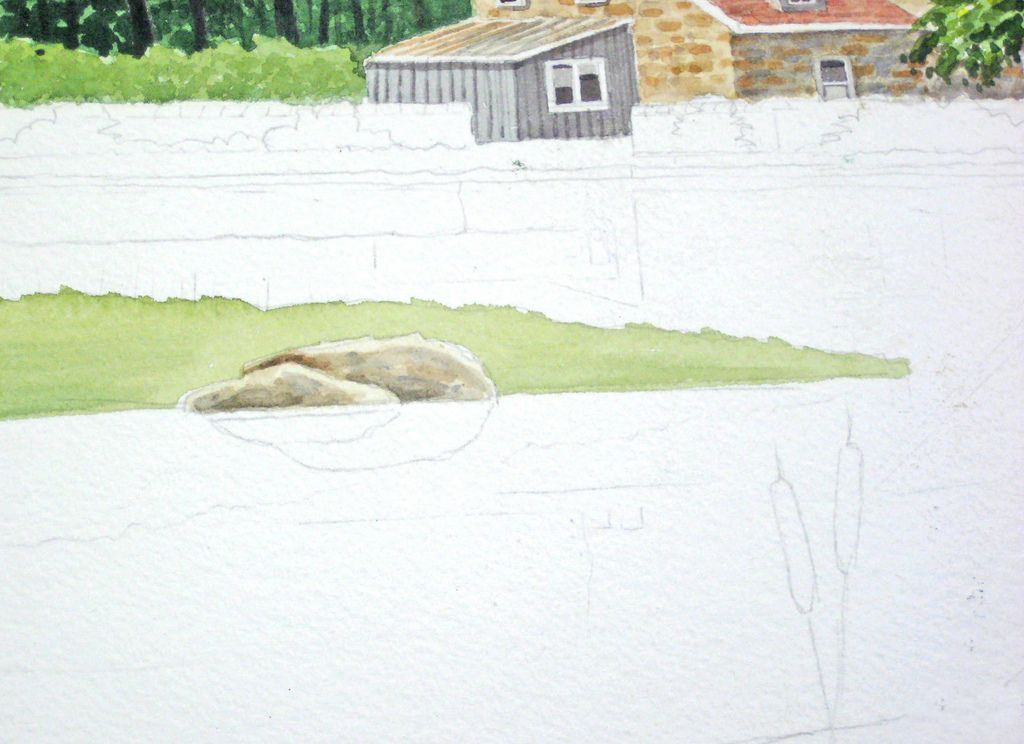
现在我们粗糙的长满草的地区使用一个初始的洗Aurolin黄色,绿色颜料和一个触摸我们阴影的颜色。我们的中间地带,岩石是现在完成了,我们可以回到他们以后一旦我们的水反射被画上。我们可能需要更多的对比。
步骤35
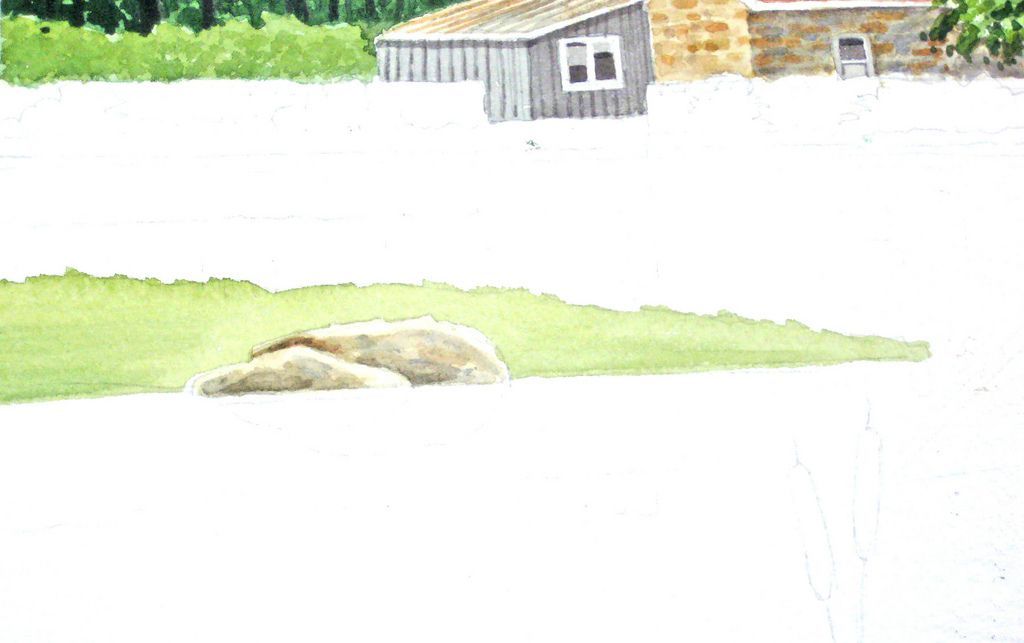
一个极端的特写镜头显示我们的岩石与各种颜色和纹理。你可以实现各种效果使用湿在湿或干刷。虽然只有一小部分的这幅画,它是一个二级中心的利益因此受到特别的关注。我大多用来# 4和# 6轮刷在这。
步骤36

你会注意到草地上是不完整的,尽管负面的绘画技术已经被用于创建一个相当粗野和野生的外观。(没人会排出去,割草)。我一直避免画任何草上面显示,在水区域,以避免“运行”当我们开始我们的水反射。我们将解决这个问题后。请注意我已经完成背景对冲区。
一步37
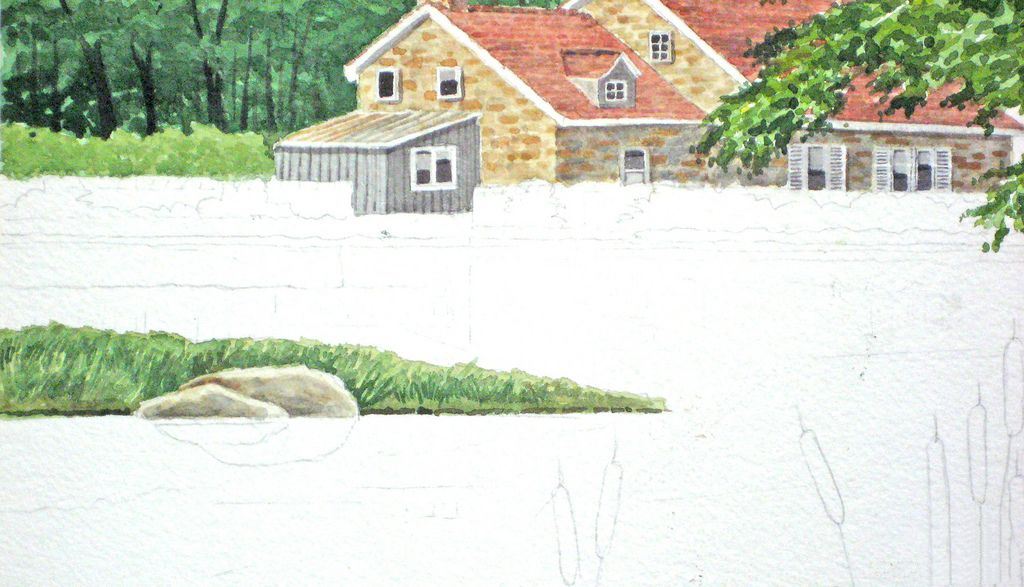
我已经完成了对冲,沿着墙和用笔写在反射区再次。我离开这直到现在,因为太多太多的铅笔准则可以被混淆在这种主题。
一步38
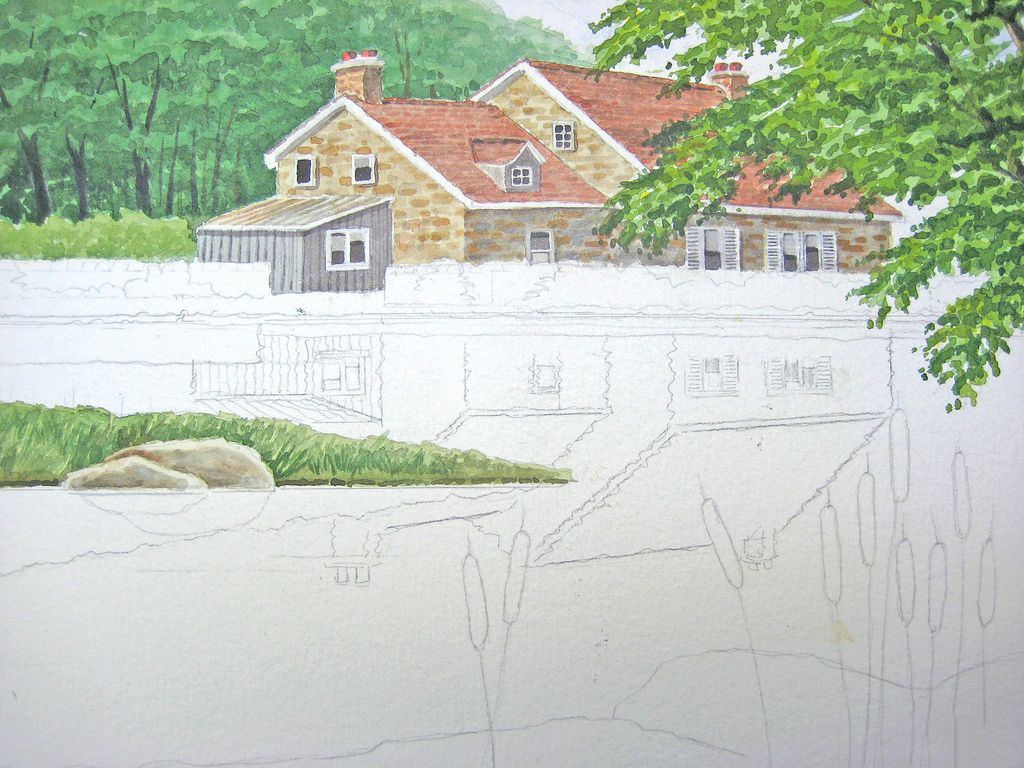
下面是它如何应该在这个阶段在我们准备解决反射。我也用液体掩蔽保护顶部的前景公牛冲所以我们可以运行对面水纹理作为我们把它涂成。下面是它如何应该在这个阶段在我们准备解决反射。我也用液体掩蔽保护顶部的前景公牛冲所以我们可以运行对面水纹理作为我们把它涂成。
一步39
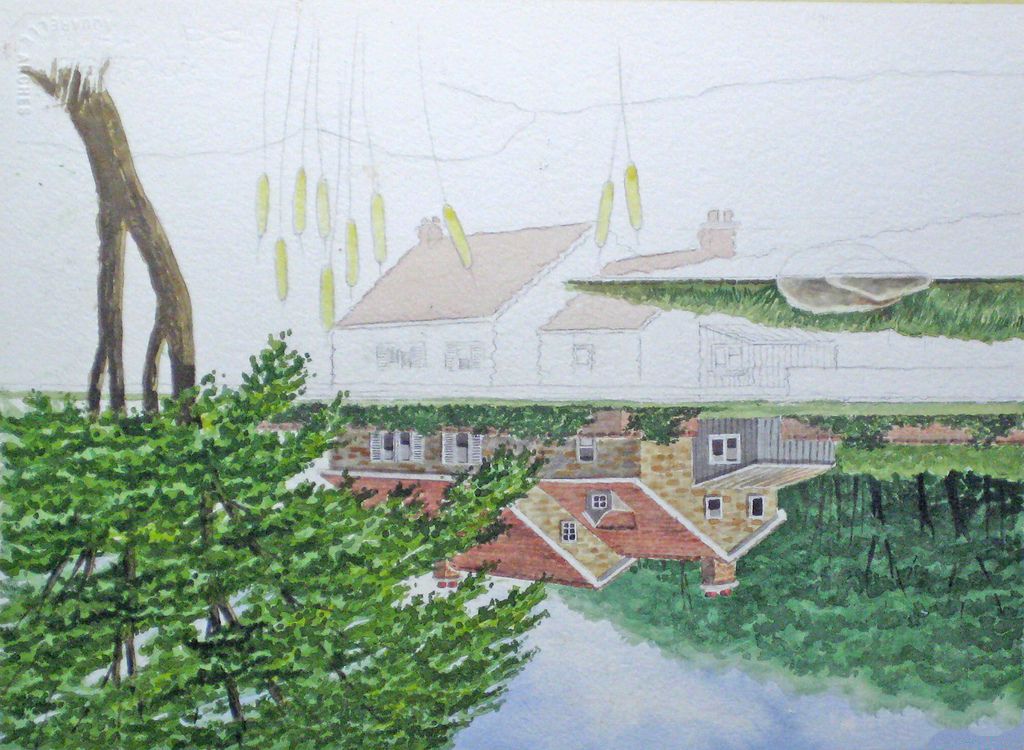
我经常把我的画颠倒当将在反思,因为它似乎减少混淆在理清颜色和色调。,事实上,我们画我们的小屋和其他一些部件在逆转,在有水的颜色和色调。我们进入未知领域一样,这里确切的颜色和色调取决于质量的水,怎么还这是。肮脏的水给更少的倒影。流动的水将扭曲的反射。我选择了一个干净的湖在平静的天气。无论多么平静,水通常有一些运动或波纹,所以我们必须表明这通过使边缘摇摆不定和不规则的。我们的颜色和色调也必须水样和相当宽松。很多在这里的个人风格和空间实验。你可能会想尝试这在一些废纸冒险之前到实际的绘画。
一步40
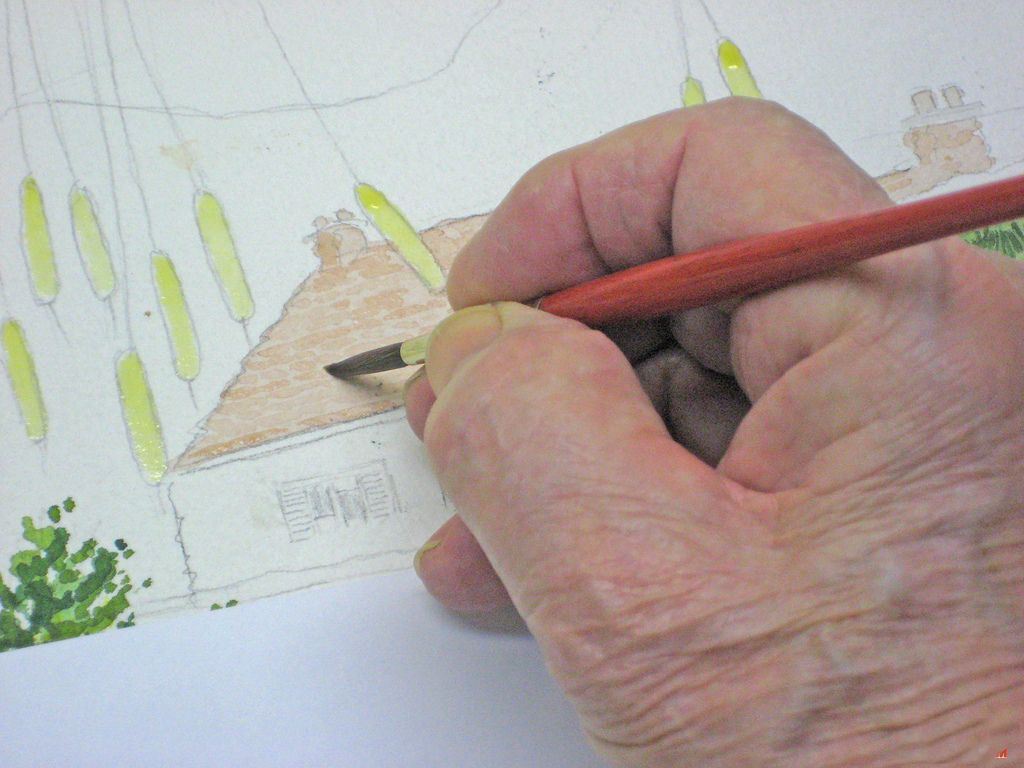
在这个极端特写镜头我大致说明了屋顶上的瓦片在一个适当的水颜色和语气。
步骤41

在完成了水呈现的小屋我把我的画回到原来的位置,并融合结果与一个1/2 "平刷,把它的边缘在地方模仿或波浪涟漪。
步骤42
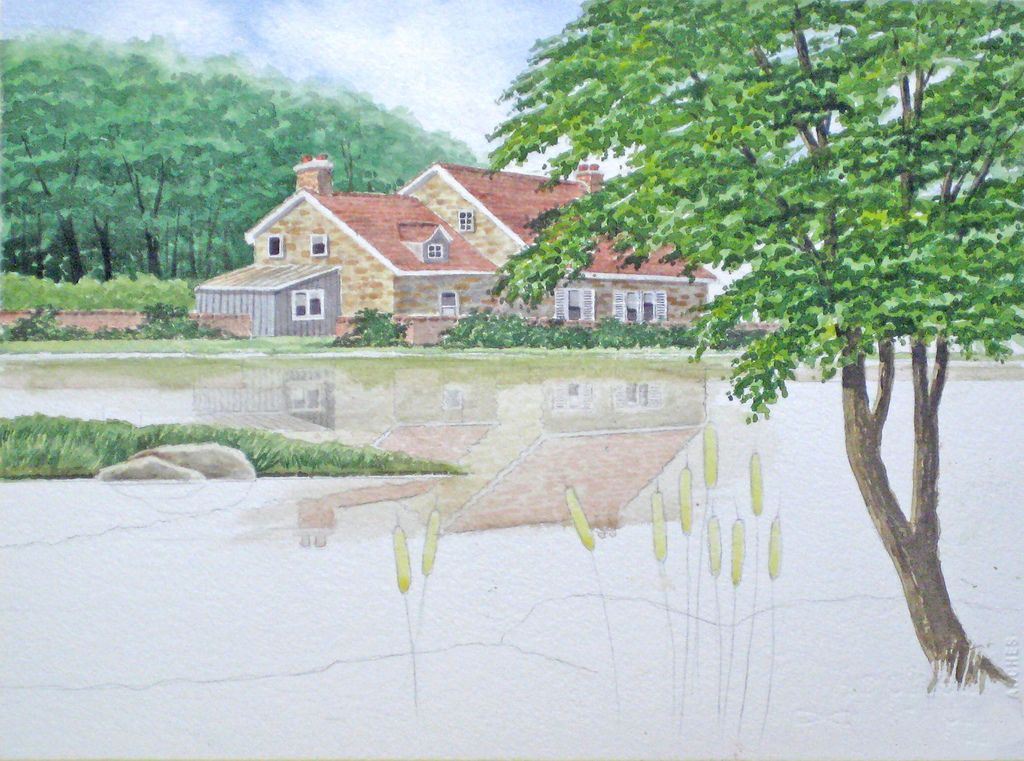
下面是它如何应该在这个阶段。一旦我们开始投入的颜色和纹理的水,我们可以混合这直到它的地位下降。有足够的空间来进行错误在这里只要你不开始与强大的主导和染色的颜色在你的第一个反射。你总是可以添加一些颜色在稍后的阶段。你会注意到一条细长的线,白色的纸,海岸线几乎满足水——它通常支付用即使它并不存在于参考照片或当你画在户外。它有助于光学错觉的海岸线差异。
一步43
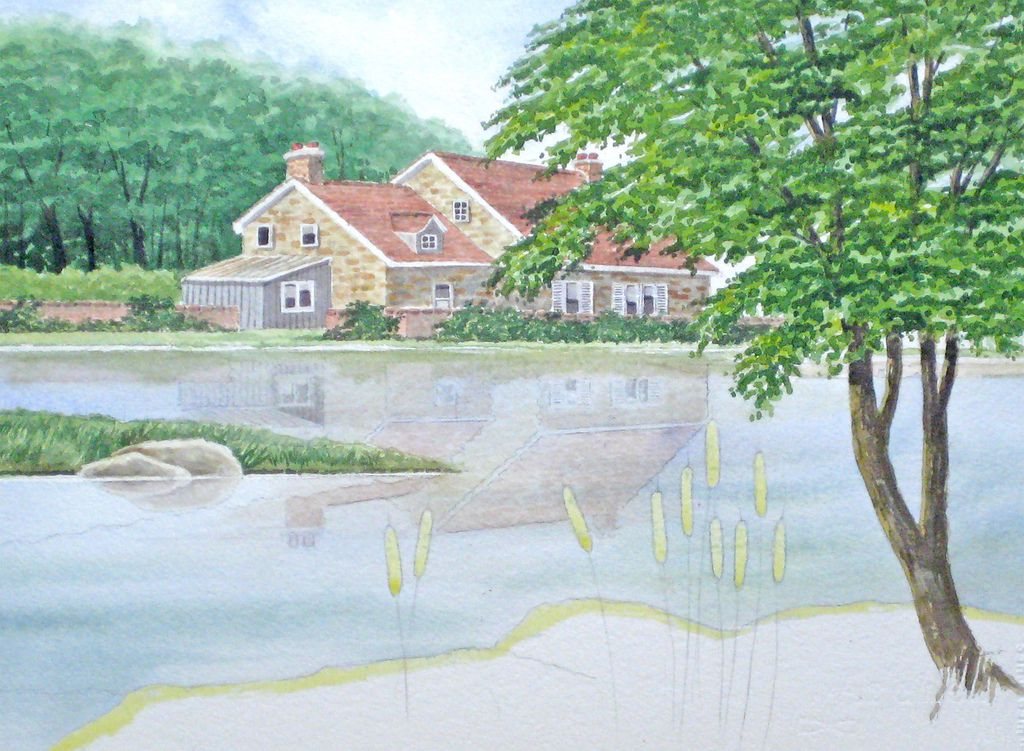
我们的反光始于清楚洗水在整个地区。使用一个1/2 "平刷和吸收到受保护的边缘,狭窄的边缘离开海岸线满足水,同样与中间地带的草和石头。虽然这仍是湿(在闪耀舞台)块洗的钴蓝色有点安特卫普蓝色。你将应用于湿纸的颜色会被稀释,所以使它比以往更强。可以首先。应用此与水平中风所以如果任何刷痕迹显示他们将看起来像水反射。从现在起我们所有的增加必须在水平中风。通知我也添加了一些水平中风的颜色使用我们的基本洗加蓝色,绿色和灰色。很多房间这里的个人风格。站在后面,看——如果它看起来像水,它是!
一步44
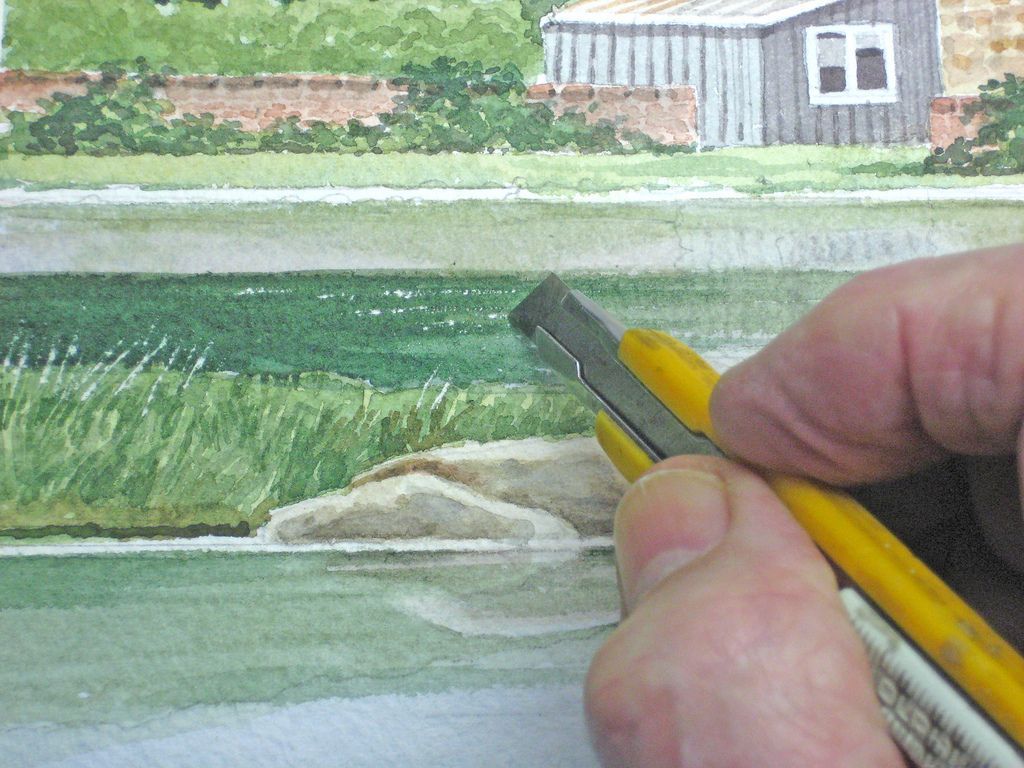
在这个极端特写镜头我已经添加了一些黑绿/蓝高于岩石地区和我解除了一些草和水用刀闪耀。你的论文必须干当你这样做时,不要过度这种技术或它将看起来很明显。刀中风必须水平在水中,但遵循草当这样做区域。
一步45

下面是它如何应该在这个阶段。没有两个画家将达到相同的结果从这类话题,这很好。你可以开始开发自己的风格和笔触。只要你保持你的额外的颜色和中风水平,不要逾越水和反思会没事的。
一步45
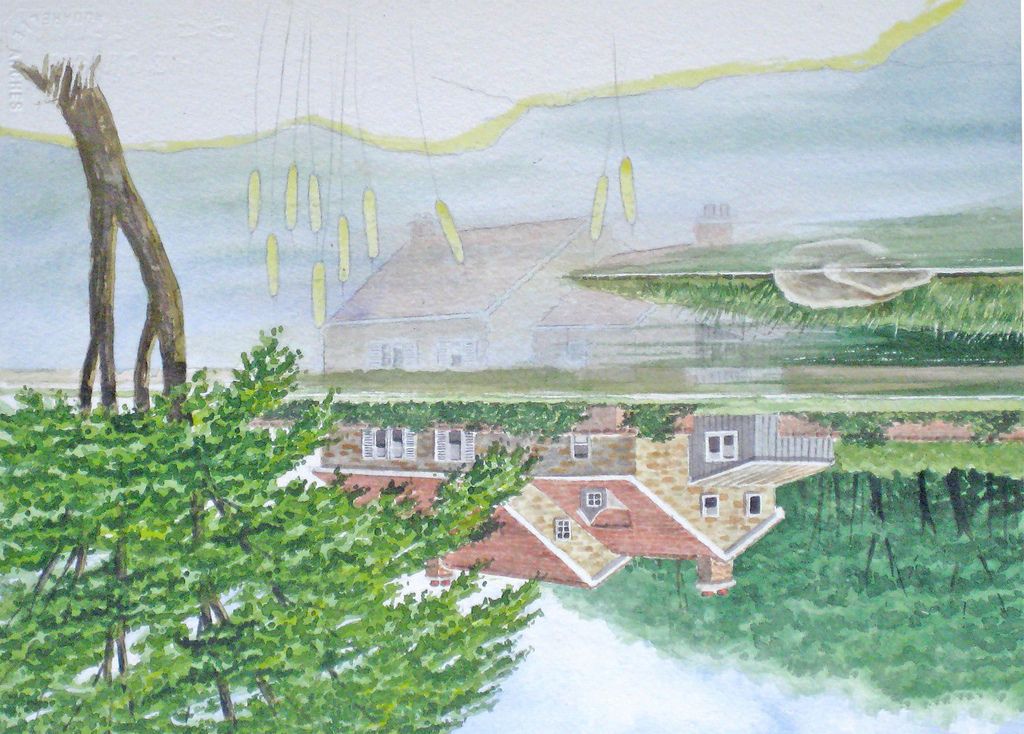
偶尔把你的画上下颠倒,退后一步。看看什么看起来不合时宜,需要修改。
一步46
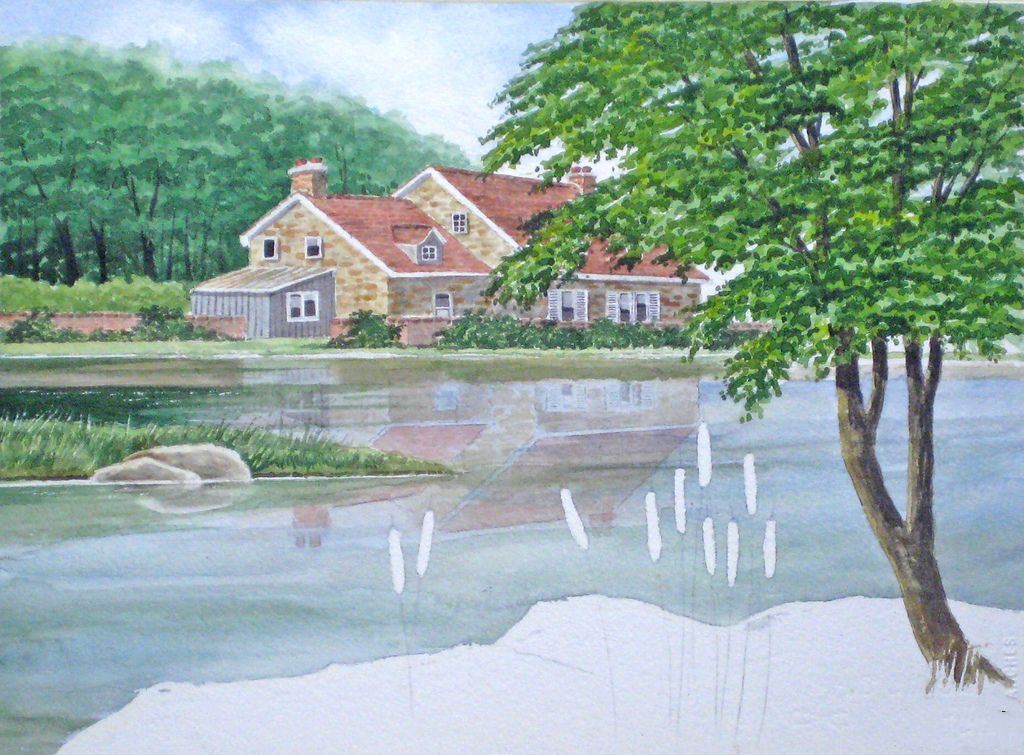
接下来我们移除所有的液体掩蔽,开始绘公牛冲。通知我修改了反射通过添加更多的色彩,增加了深度的水的颜色在屋顶反射和阴影区域。作为你的每个绘画将不同的颜色和色调,这一修改将允许您使用您自己的风格范围。
一步47
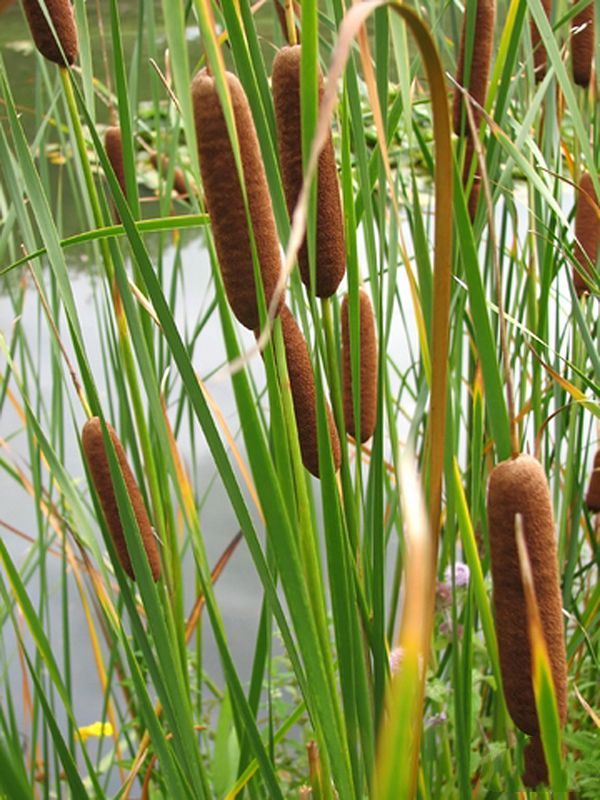
这是一个照片参考典型的丛公牛冲。
一步48
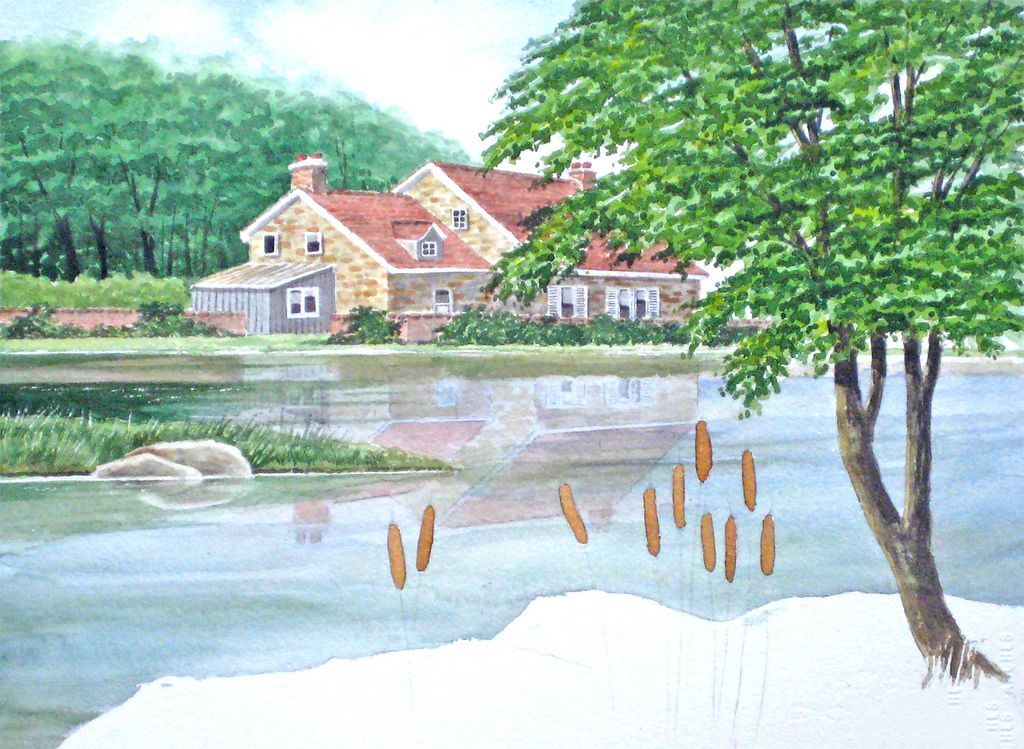
开始洗生黄土和一点点的深褐色得到那个生锈的棕色看起来。
一步49
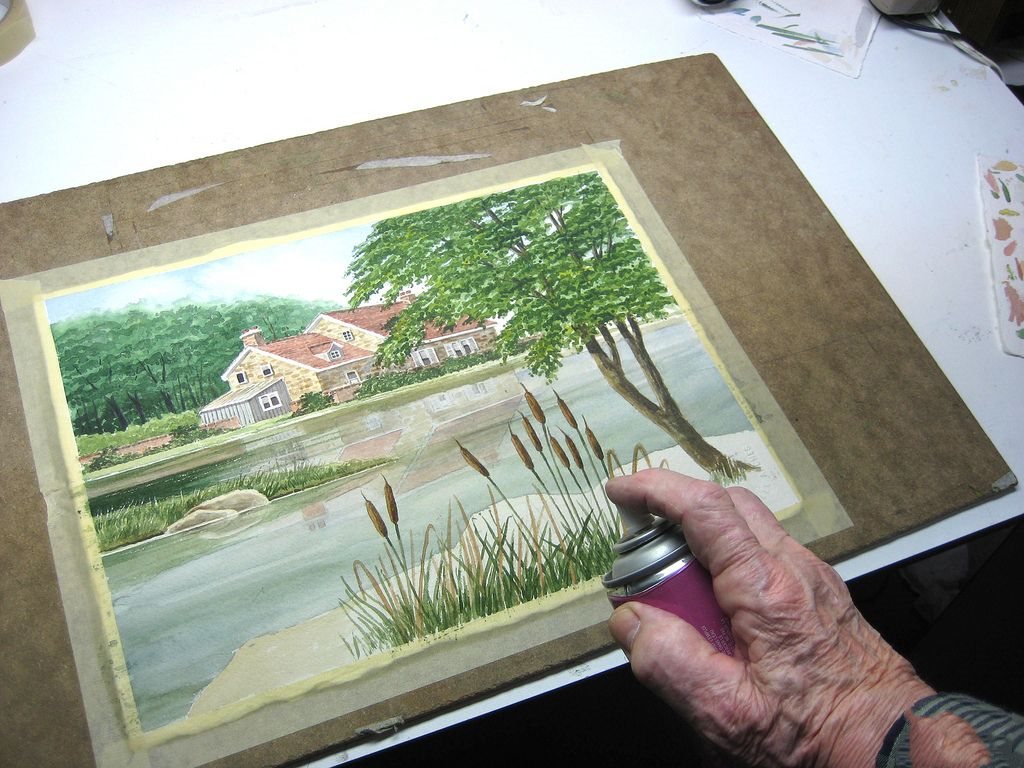
在这里我使用一些传球的头发喷雾取代了一个专业的固着在我完成了我的画下的公牛冲。这将防止背景岩石颜色从跑步当我完成那些岩石。如果我把岩石在第一很难覆盖深色的颜色和纹理,油漆在灌木丛和液体掩蔽会太无聊和看起来笨拙。
一步50
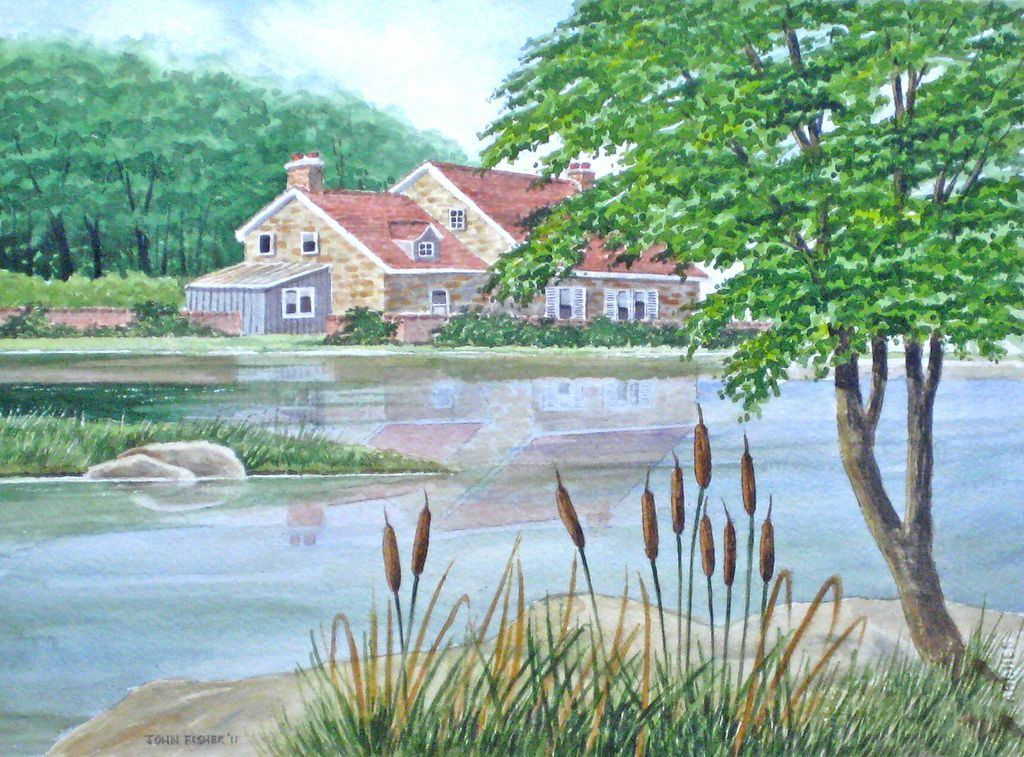
所有做的。我添加了一些更多的使用我们的负面前景树叶绘画技巧和一些收尾工作放在这里和那里。我通常让完成画站在在我的工作室几天所以我可以走,注意最后一分钟触动我觉得应该做的。学生经常问我“我怎么知道当我画完了吗?”我的回答通常是回避如“这一切都取决于”。初学者(和一些人应该知道更好的)经常加班一幅画。学会知足。毕竟,这是接下来的绘画,真正重要的,不是吗?
原文如下:
Step 34
Now we rough in the grassy areas using an initial wash of Aurolin Yellow, Sap Green and a touch of our shadow colour. Our middle-ground rocks are finished for now, and we may come back to them later once our water reflection are painted in. We may need more contrast.
Step 35
An extreme close-up show our rocks with various colours and textures. You can achieve various effects using wet-in-wet or dry brush. Although only a small portion of this painting, it’s a secondary centre of interest so it deserves special attention. I used mostly #4 and #6 round brushes on this.
Step 36
You will notice the grass is incomplete, although the negative painting technique has been used to create a rather unkempt and wild appearance. (Nobody is going to row out there and cut the grass). I have avoided painting any grass that shows above, in the water area, to avoid “runs” when we begin our water reflections. We will tackle this later. Note also I’ve complete that background hedge area.
Step 37
I’ve completed the hedge that runs along the wall and pencilled in the reflection area again. I left this until now as too many pencil guidelines can be confusing in this sort of subject.
Step 38
Here’s how it should look at this stage as we prepare to tackle the reflections. I’ve also used liquid masking to protect the tops of the foreground bull-rushes so our water texture can run right across as we paint it in.Here’s how it should look at this stage as we prepare to tackle the reflections. I’ve also used liquid masking to protect the tops of the foreground bull-rushes so our water texture can run right across as we paint it in.
Step 39
I often turn my painting upside down when putting in reflections as it seems to lessen the confusion when sorting out the colours and tones. We are, in effect, painting our cottage and some other parts in reverse and in watery colours and tones. We’re moving into unknown territory here, as the exact colour and tone will depend on the quality of the water and how still it is. Dirty water gives fewer reflections. Moving water will distort the reflections. I’ve chosen a nice clean lake in calm weather. No matter how calm, water usually has some movement or ripples, so we must indicate this by making the edges wobbly and irregular. Our colours and tones must also be watery and fairly loose. Lots of room here for personal style and experiment. You might want to try this out on some scrap paper before venturing onto the actual painting.
Step 40
In this extreme close-up I’m roughly indicating the tiles on the roof in an appropriately watery colour and tone.
Step 41
Having completed my watery rendering of the cottage I turn my painting back to its original position and blend in the results with a 1/2″ flat brush, turning it on its edge in places to imitate ripples or waves.
Step 42
Here’s how it should look at this stage. Once we start putting in the colour and texture of the water, we can blend this in until it’s less dominant. There’s plenty of room for error here as long as you don’t start off with strong dominant and staining colours in your first reflections. You can always add some colour at a later stage.You will notice a long thin line of almost white paper where the shoreline meets the water – it usually pays to put this in even if it doesn’t exist in the reference photograph or while your painting outdoors. It helps the optical illusion of shoreline difference.
Step 43
Our reflections begin with a clear wash of water over the whole area. Use a 1/2″ flat brush and soak up to the protected edges leaving that narrow edge where the shoreline meets the water, and the same with the middle ground grass and rocks. While this is still wet (at the glisten stage) block in a wash of Cobalt Blue with a touch of Antwerp blue. As you will be applying this to wet paper the colour will be diluted, so make it stronger than usual. Try it out first. Apply this with horizontal strokes so if any brush marks show they will look like water reflections. From now on all our additions must be in horizontal strokes. Notice I’ve also added some horizontal strokes of colour using our basic wash with added blue, green and gray. Lots of room here for personal style. Stand back and look – if it looks like water, it is!
Step 44
In this extreme close-up I’ve added some dark green/blue above the rock area and I’m lifting out some grass and water sparkle with a knife. Your paper must be dry when you do this, and don’t overdo this technique or it will look obvious. Knife strokes must be horizontal in the water, but follow the grass when doing that area.
Step 45
Here is how it should look at this stage. No two painters will achieve the same results from this sort of subject, and that’s good. You can begin to develop your own style and brush strokes. As long as you keep your additional colours and strokes horizontal and don’t overdo it the water and reflections will be fine.
Step 45
Occasionally turn your painting upside down and step back. See if anything looks out of place and in need of modification.
Step 46
Next we remove all the liquid masking and begin painting the bull rushes. Notice I have modified the reflections by adding more colours to the water and increased the depth of colour in the roof reflection and some shadow areas. As each of your paintings will differ in colour and tone, this modification will allow you scope to use your own style.
Step 47
Here is a photo reference of a typical clump of bull rushes.
Step 48
Begin with a wash of Raw Sienna and a touch of Burnt Sienna to get that rusty brown look.
Step 49
Here I’m using a few passes of a hair spray substituting for a professional fixative after I completed my under-painting of the bull rushes. This will prevent the background rock colour from running when I complete those rocks. If I put the rocks in first it would be difficult to cover the darker colours and texture, and to paint in all that undergrowth with liquid masking would be too tiresome and look clumsy.
Step 50
All done. I’ve added some more foreground foliage using our negative painting technique and put in a few finishing touches here and there. I usually let completed painting stand around in my studio for a few days so I can walk by and note any last minute touches I feel should be done. Students often ask me “How do I know when my painting is finished?” My answer is usually evasive as in “It all depends”. Beginners (and some of us who should know better) often overwork a painting. Learn when to leave well enough alone. After all, it’s the NEXT painting that really counts, isn’t it?








